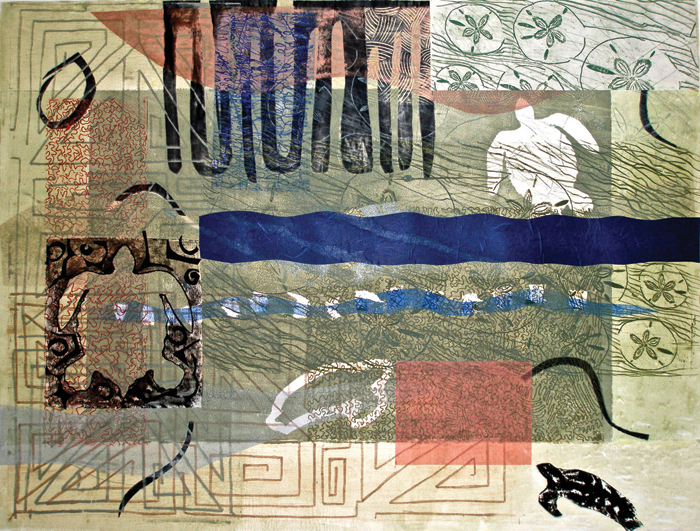Carolyn Shattuck
Into My Space Final
By: B. Amore
Compass Music and Arts Center – Brandon, VT – cmacvt.org/ – Through September 14, 2019
Carolyn Shattuck is a consummate printmaker, using monotype, dry point, painting, stencils and mixed media to achieve her unique results. Some pieces rely on highly defined patterns for effect. Other works are more painterly. Shattuck’s work is bold, exploratory and questioning. Despite titles that sometimes point the viewer in the direction of the artist’s intent, different layers of meaning reveal themselves upon deeper looking.
In Turtle Series II, there is a progression through the piece, as the turtle changes color and form, starting out as black, passing through a complex world and evolving into transparent white at the top. The entire mixed-media print, in subtle shades of green-grey, with currents of blue and mysterious patterns has the fluidity of water. The inclusion of a calligraphic open circle brings a sense of peace to the journey.

Carolyn Shattuck, Turtle Series II, 2008, collage, Japanese papers, dry point, monotype, 35 x 27″. Courtesy of the artist.
Interior I, a painterly work, has a Matisse-like feel, with its emphasis on color and space. Blue circles with bright yellow centers are mesmerizing with their liquid sense of seeping into the paper. The central mug and bottle cast long, dark shadows onto a highly patterned tablecloth. The complex layering of foreground and background is a result of the transparency that printmaking allows.
In addition to her printmaking skills, Shattuck is architectural in the way she plans and executes the intricate constructions for her sculptural books, which highlight her interest in social and environmental causes. In Triple Decker, she deftly interweaves ethnic patterns, a clothesline and cut out people to reference 19th and 20th-century immigrant life. Wardrobe Chronicles and Women Helping Women speak to raising awareness of women’s rights. The Urn Book unfolds into a series of New England gravestones interspersed with original inscriptions and quotes referencing the essential nature of change, loss and renewal.
Shattuck’s work sometimes springs from painful personal experience yet becomes universal as she integrates the process of healing into her art. The resultant pieces are rich tapestries, incorporating dense bright colors and multiple patterns. A sense of wonder and question is inherent in the work and Shattuck never disappoints. She entices us on to the next journey.
ARTS SHOW – CAROLYN SHATTUCK
A LOOK AT BOOK ART
Jul 25, 2014
THE QUILTS OF GEE’S BEND, VOL. 2
Nov 11, 2011
Remarkable works of art, from a tradition that dates back four generations, are made by women who live in a rural African, American Alabama community. The goal was to improvise with established designs to create a unique composition. Materials such as old clothes, cornmeal sacks, denim jeans and fabrics that fit the color palette were used. This book honors the unnamed women who made these unusual and stunning quilts. The Quilts of Gee’s Bend, vol. 2 is a flexagon, H- 3.5″ x W-8.5″ x D-8.5″. inkjet printed on Epson paper. Edition 25.
Purchased by: Brooklyn Museum Library – Brooklyn, NY
PRESS RELEASES
Sometimes it’s good to acknowledge that our small city, Rutland, has an embarrassment of riches. For instance, take City Hall. It is alight with a new exhibit of paintings by Rutland artist Carolyn Shattuck.
The Castleton University Gallery Program refreshes the exhibits in Rutland’s City Hall every few months, and people who work there say that they are getting used to the art, like it a lot, and miss it when they are “in between” exhibits. The current exhibit will be up for a few months.
Our City Hall is a grand building, but it can seem dark at times. Not now! Shattuck’s paintings splash color and heat on the walls and up the big, old staircase.
The exhibit is comprised of large bright still life paintings made with oil and Dorland wax on canvas. Shattuck says that for these paintings, she found objects at flea markets in Mexico and arranged them with printed fabric, creating odd groups of random colorful things: curvy glass pitchers, bright tablecloths, glassware with cut surfaces, little sculptures of lizards and dogs.
The objects, though fetching, are less interesting than the way the artist presents them. Many are glass, so the bright fabric beneath them penetrates the wavy or carved surfaces of the glassware, emerging distorted. The wrong side of the fabric reveals the prints in muted colors. Everything tilts in ways our eyes don’t quite believe. And for me, the strange little dog statue is riveting. I’m not even sure he is a dog. Do they have big-eared animals like this in Mexico? Small, surreal dogs?
Shattuck created a bright, somewhat foreign environment in these paintings. They feel southern: full of sun and warmth and a tipsy perspective: a striking contrast to the well-mannered hallways of our historic, shady and resonant City Hall.
A second series hangs in the small first floor corridor leading to the parking lot. Shattuck made these works by carving patterns into aluminum sheets and using them to print color onto paper. Then she layered more printed images atop the first. And, she cut up other works and added them, making more layers. Shattuck says she likes to repurpose her work, lifting an image from one print and placing it atop a new work. The pieces in this series are light-spirited and refer to the sea. Again, Shattuck gives her viewers a breath of outdoors. Looking at them, you can just about smell the salt air.
Go to City Hall and look at art. Or go to City Hall to do something businesslike and notice the art. It’s a gift.









